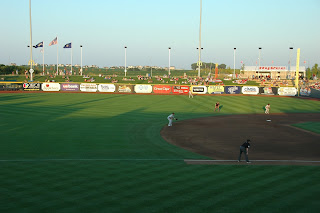 I love the
movie “Field of Dreams”. Many consider
it overly sentimental, but I put it up there with “Bull Durham” as one of my
two favorite baseball movies.
I love the
movie “Field of Dreams”. Many consider
it overly sentimental, but I put it up there with “Bull Durham” as one of my
two favorite baseball movies.
Much of the
allure of “Field of Dreams” is the setting in an Iowa cornfield. For the movies, baseball in a cornfield is
fine. But I recently saw several
ballgames in a Midwestern cornfield and found it distressing.
Faced with
the need for a new ballpark five years ago, the Omaha Triple-A ballclub, now
known as the Storm Chasers, left their old location near downtown Omaha to
build a new ballpark fifteen miles away.
 Not only is
Werner Field remote from Omaha, it’s remote from pretty much everything. It’s mostly surrounded by cornfields and
hayfields. Except for a row of homes on
a ridgeline beyond the rightfield fence, one other residential neighborhood,
and a few industrial buildings, the ballpark is four miles from anything.
Not only is
Werner Field remote from Omaha, it’s remote from pretty much everything. It’s mostly surrounded by cornfields and
hayfields. Except for a row of homes on
a ridgeline beyond the rightfield fence, one other residential neighborhood,
and a few industrial buildings, the ballpark is four miles from anything.
Nor are there
good ways to reach the ballpark except by car.
There’s no transit to the park.
There is a bike lane on the rural highway leading to the park, but the
lane hadn’t been cleaned in awhile. For
the three games I watched at the ballpark, I didn’t see a single bicyclist or
pedestrian either on their way to the park or going anywhere else.
To be fair, the
park may someday be adjoined by other non-agricultural land uses. There were signs describing the ballpark as the
first phase of a development planned to eventually include residential, office,
retail, and industrial uses. And the
Omaha-Council Bluffs metropolitan area is growing enough, roughly 100,000
between 2000 and 2010 with a similar rate expected to continue, to absorb the
new development.
 But a good
urban plan would have allowed the downtowns to accept 100,000 new people. And even failing that, there are many
cornfields closer to Omaha and adjoining existing development that could have
been converted into a ballpark.
But a good
urban plan would have allowed the downtowns to accept 100,000 new people. And even failing that, there are many
cornfields closer to Omaha and adjoining existing development that could have
been converted into a ballpark.
Werner Park is
the worst kind of drivable suburban sprawl.
Indeed, calling it suburban is a stretch. It’s drivable rural sprawl. It’s a nice ballpark, but in a horribly wrong
location.
To make the
situation worse, there was an available urban alternative. The park from which the Storm Chasers moved
was Rosenblatt Stadium, which also served as the long-time home of the College
World Series. Rosenblatt was aging and a
new venue was required. So the Storm
Chasers moved fifteen miles to their new 8,500-seat ballpark in a cornfield. And a new 24,000-seat ballpark, TD Ameritrade
Park, was built in downtown Omaha for the College World Series.
 That’s
right. Two largely comparable but separate
ballparks, with a combined construction cost of $164 million, were built simultaneously
fifteen miles apart.
That’s
right. Two largely comparable but separate
ballparks, with a combined construction cost of $164 million, were built simultaneously
fifteen miles apart.
I asked a
number of folks why the functions of the two parks hadn’t been combined. Two reasons were given. First, the College World Series would have required
the Storm Chasers to take an annual two-week roadtrip. Second, 24,000 seats are too many for a
Triple-A ballclub.
As a former
minor league ballclub owner, I understand the latter concern. If too many seats are available, fans don’t
have a reason to make advance purchases.
Instead, they can plan on buying walk-up tickets. But if they don’t have tickets in hand, they
can easily make gameday decisions to skip the game. It’s the reason that many new Major League
ballparks have 40,000 seats, compared to the 55,000-seat stadiums of three
decades ago.
So the
scheduling and capacity issues are legitimate concerns. But were they sufficient to justify building
two ballparks, one of which is the definition of sprawl? Not even close. The issues are challenges to be overcome, not
roadblocks.
Schedule-makers
must regularly accommodate special scheduling concerns.
And making a
ballpark that will function well at 24,000 seats for two weeks and at 10,000
seats for the remainder of the year is a design criterion which architects
would love to tackle. Perhaps the upper
sections could be blocked off except during the College World Series and a
second, less grand, entrance provided for the Triple-A games.
As an
architect friend noted when I told him about the dual ballparks, “I understand
the constraints, but they don’t justify that solution.”
And the
rewards for solving the challenges would have been significant. Attendance for the Storm Chasers would likely
have been higher in downtown Omaha.
Watching a ballgame would become available to those who rely on
transit. And the streetlife around TD
Ameritrade Park would receive a boost.
It’s a nice neighborhood, but one that would have benefited from several
thousand Triple-A ball fans going to and from 72 ballgames a year.
For “Field
of Dreams”, baseball in a cornfield is fine.
But for real life ballclub in a world where we should be more aware of
using our assets wisely, it’s a huge blunder.
In baseball terms, Werner Park was a whiff.
As always,
your questions or comments will be appreciated.
Please comment below or email me.
And thanks for reading. - Dave Alden (davealden53@comcast.net)
No comments:
Post a Comment